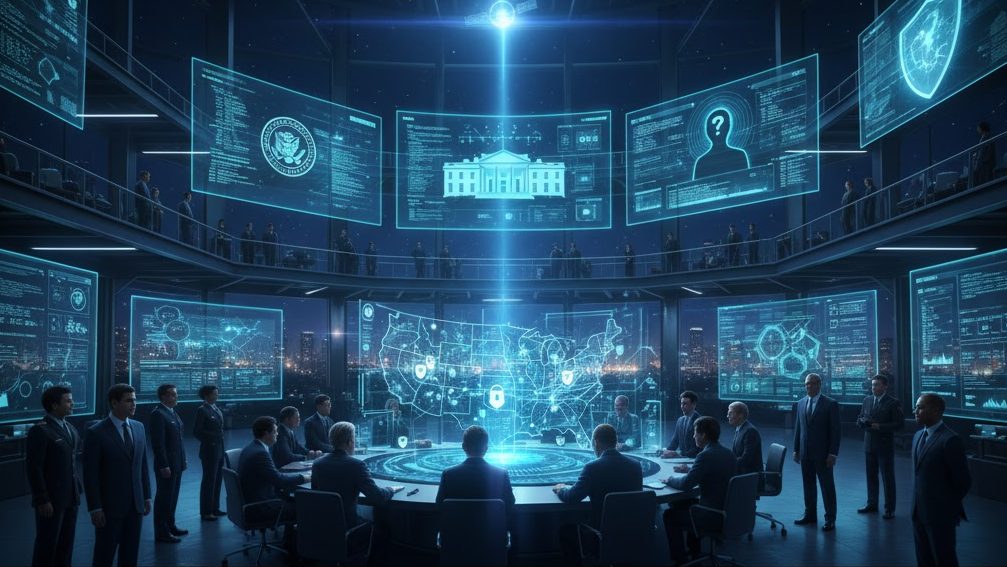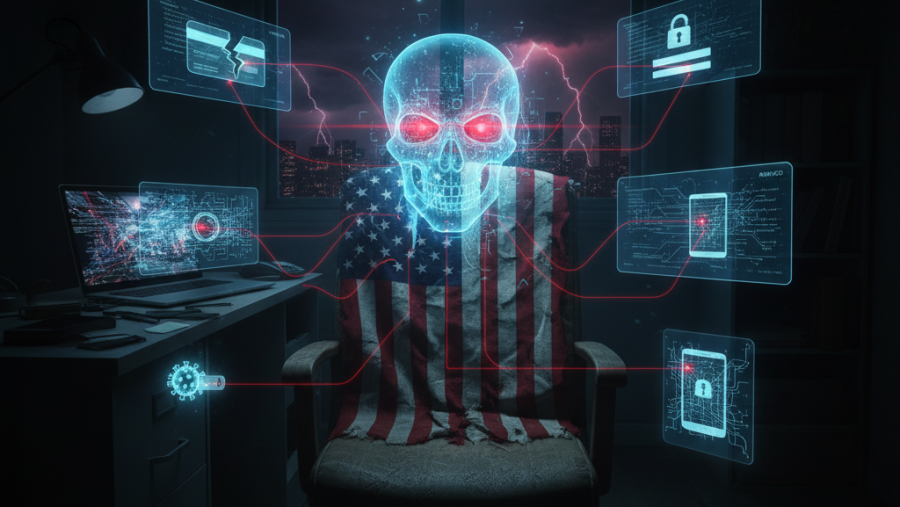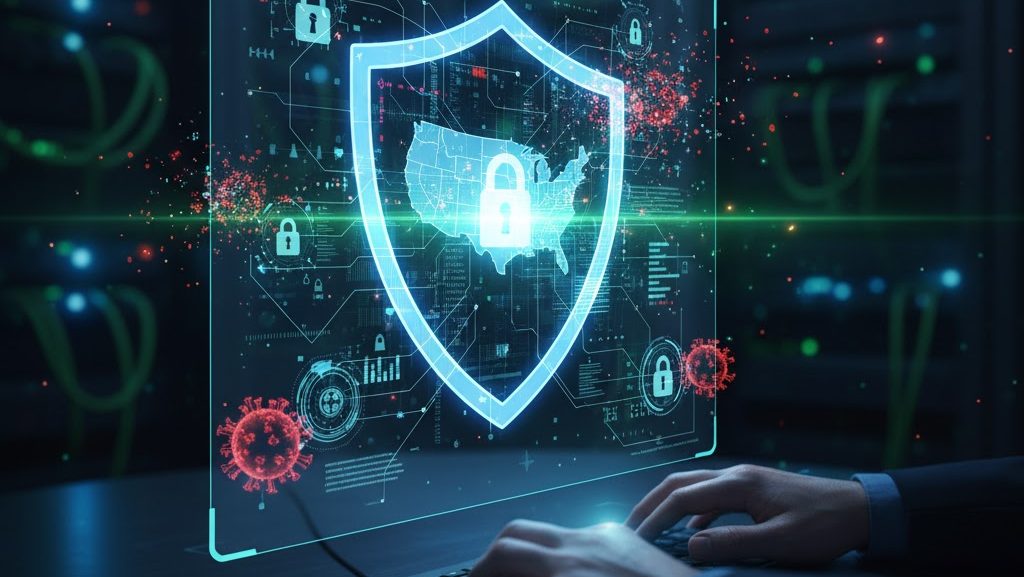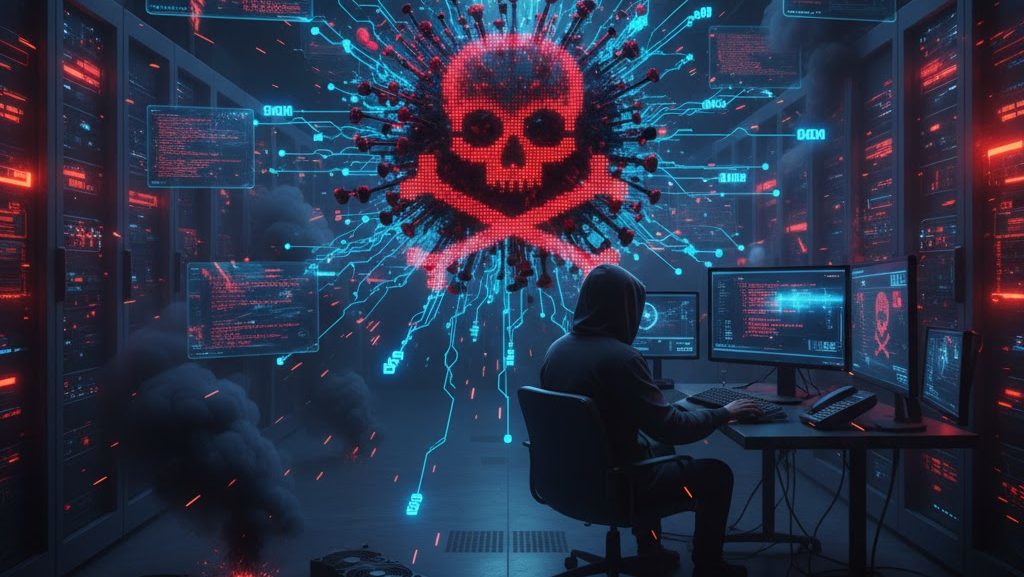Cyberattacks are no longer hypothetical — they’re daily reality. From ransomware that halts hospitals to sophisticated state-level espionage, cyber threats touch businesses, governments, and people in ways that feel personal and urgent. This long-form guide explains how the U.S. government handles cybersecurity threats, what each agency does, how public-private collaboration works, what recent research shows, and — most importantly — what actionable steps organizations and individuals can take right now. The tone is empathic and reassuring: the system is complex, but there are practical defenses and clear responsibilities.
At a glance — the U.S. cybersecurity ecosystem (short summary)
- The U.S. uses multiple agencies with complementary roles: coordination and civilian defense (CISA/DHS), intelligence and signals analysis (NSA), military offensive/defensive cyber (USCYBERCOM/DoD), law enforcement and prosecution (DOJ/FBI), policy and strategy at the White House (NSC/ONCD), and standards/research (NIST/NITRD). The White House+3CISA+3National Security Agency+3
- The government emphasizes public-private collaboration: most critical infrastructure is privately owned, so coordination, information sharing, and technical assistance are core tools. The White House
- The U.S. pursues a mix of defense, deterrence, disruption, and prosecution — technical protection, attribution and naming of threat actors, sanctions and indictments, and assistance to victims. Department of Justice+1
Who does what? Key agencies and their responsibilities
Below is a practical table that maps major federal actors to their core cyber roles.
| Agency / Office | Core role in cybersecurity | Typical actions |
|---|---|---|
| Cybersecurity & Infrastructure Security Agency (CISA) — DHS | National coordinator for cyber defense of civilian networks and critical infrastructure | Issue alerts, patch directives for federal agencies, run incident response playbooks, share indicators of compromise, host public guidance (e.g., StopRansomware). CISA+1 |
| National Security Agency (NSA) | Signals intelligence & advanced technical cybersecurity support for national security systems and the defense industrial base | Vulnerability discovery, threat hunting, technical advisories, and collaboration with private sector via the Cybersecurity Collaboration Center. National Security Agency |
| U.S. Cyber Command (USCYBERCOM) — DoD | Military cyber operations (defensive and, when authorized, offensive) to defend DoD networks and support national defense objectives | Exercises (e.g., Cyber Flag), offensive operations to disrupt adversary capabilities, coordination with allies. Cybercom |
| Federal Bureau of Investigation (FBI) & Department of Justice (DOJ) | Investigation and disruption of cybercriminal operations; prosecution of offenders | Indictments, asset seizures, transnational law enforcement cooperation, public attribution of state actors. Example: DOJ charged groups tied to state actors. Department of Justice |
| National Institute of Standards and Technology (NIST) | Develops technical standards, frameworks, guidance (e.g., NIST Cybersecurity Framework) | Guidance for risk management, research for sector-specific security, standards for federal agencies and industry. NIST Publications |
| White House / Office of the National Cyber Director (ONCD) & NSC | Policy, strategy, national priorities, interagency coordination | National Cybersecurity Strategy, executive orders (e.g., EO 14028) and cross-government coordination. The White House+1 |
(These roles overlap by design: resiliency depends on information sharing and coordinated response across these actors.)
How the government actually responds to incidents — practical steps
When a significant cyber incident affects the U.S. — whether a federal network, critical infrastructure, or a major private firm — the response typically proceeds along these lines:
- Detection & initial reporting. Victim organization detects or is alerted to an incident. Federal agencies encourage immediate reporting; CISA offers threat indicators, and many firms report to the FBI or CISA under voluntary information-sharing mechanisms. CISA+1
- Triage & coordination. If the incident affects federal systems or critical infrastructure, CISA and relevant sector-specific agencies step in to triage, provide guidance, and coordinate response. The Federal Incident & Vulnerability Response Playbooks define roles for federal agencies. CISA
- Technical containment & mitigation. Actions include isolating affected systems, deploying emergency patches, revoking credentials, and applying cross-organizational rules (e.g., emergency directives to patch vulnerable products). CISA has issued emergency directives in high-risk supply-chain incidents. Wall Street Journal+1
- Investigation & attribution. The FBI, NSA, and other partners investigate to identify perpetrators — criminal groups or nation-state actors. DOJ may pursue indictments or sanctions once evidence supports attribution. Examples include DOJ charges of foreign contract hackers. Department of Justice
- Remediation & recovery. Federal guidance (CISA’s StopRansomware, NIST recovery guidance) helps organizations restore systems, strengthen defenses, and harden against recurrence. CISA+1
- Deterrence & disruption. U.S. authorities may impose sanctions, carry out offensive cyber operations (by USCYBERCOM where authorized), or take legal action to disrupt criminal infrastructure. This is part of a broader strategy to make attacks less appealing or less effective. Cybercom+1
Top 10 ways the U.S. government prevents and mitigates cyber threats (listicle)
- Information sharing with private sector — Through partnerships, advisories, and platforms (e.g., Cybersecurity Information Sharing Act (CISA) initiatives, ISACs). Public-private intel sharing helps defenders patch faster. CISA
- Issuing binding directives for federal agencies — Federal agencies must meet directives and patch mandates (e.g., Executive Order 14028, CISA emergency directives). CISA+1
- Standard setting and guidance (NIST) — NIST frameworks guide risk management, zero trust adoption, and incident response. NIST Publications
- Law enforcement actions and indictments — DOJ and FBI investigate and prosecute cybercriminals and sometimes publicize charges to deter activity. Department of Justice
- International diplomacy and sanctions — Coordinated sanctions and diplomatic pressure target state-sponsored cyber campaigns.
- Offensive cyber operations (when authorized) — USCYBERCOM and allied partners may disrupt adversary capabilities. Cybercom
- Capacity building and resilience programs — Grants, training, and assistance for state/local governments and critical sectors. CISA
- Supply-chain risk management — Post-SolarWinds reforms, agencies focus on securing software supply chains and vendor risk. The White House
- Public education and ransomware guidance — CISA’s StopRansomware and other resources help organizations harden defenses and respond effectively. CISA
- Investment in R&D and standards (NITRD, federal research plans) — Long-term federal R&D (NITRD) funds cybersecurity research and workforce development. nitrd.gov
Case studies & recent events — what they teach us
F5 supply-chain compromise and emergency directives
In mid-October 2025, CISA issued an emergency directive requiring federal civilian agencies to patch F5 security products after a breach exposed sensitive source code and configurations — demonstrating rapid federal action to close high-risk supply-chain holes. Emergency directives are a strong tool because they compel immediate action across federal networks. Wall Street Journal
DOJ indictments of foreign hacking networks
DOJ prosecutions of foreign-linked hacking groups show how legal action helps expose actor tradecraft and deter activity. Such cases often combine technical forensics with diplomatic coordination. Department of Justice
The rise of AI-enabled attacks
Industry reporting indicates growing use of AI tools in phishing, identity cloning, and disinformation campaigns — which accelerates both the scale and sophistication of attacks, and forces government defenders to adapt detection methods accordingly. The government is investing in AI research and guidance but warns defenders to be quicker in adoption. AP News
What research and universities say — evidence that shapes policy
- NIST and academic research emphasize that standards and frameworks (like NIST CSF and zero-trust principles) measurably improve organizational preparedness and reduce the time to recover from incidents. NIST publications guide federal and private practice. NIST Publications
- A 2025 case-study meta-analysis by researchers (e.g., TU Delft proceedings) evaluated major government breach responses (SolarWinds, OPM, others) and concluded that proactive supply-chain controls, layered identity protections, and resilient incident playbooks significantly reduce operational and financial impact. The study underscores the value of preparedness over reactive-only responses. proceedings.open.tudelft.nl
- University studies repeatedly show public-private collaboration (information sharing, joint exercises) improves detection speed and containment. This evidence informs initiatives like CISA-led exercises and USCYBERCOM’s Cyber Flag. Cybercom+1
How individuals and organizations interact with federal cyber defenses (actionable pathways)
For organizations (SMBs to enterprise)
- Report incidents quickly. If you suffer ransomware or a major breach, report to CISA and the FBI. Early reporting leads to more assistance and better national situational awareness. CISA
- Adopt federal guidance. Implement core NIST recommendations (identify, protect, detect, respond, recover) and the zero-trust model where feasible. Use CISA’s Incident Response Playbooks as a template. NIST Publications+1
- Participate in information sharing. Join sector ISACs (Information Sharing and Analysis Centers) and leverage CISA alerts and FBI threat advisories.
- Harden supply chains. Vet vendors, require secure software development practices, and ask for SBOMs (software bill of materials) where appropriate. Federal policy increasingly requires supply-chain transparency. The White House
For individuals
- Use multi-factor authentication (MFA) and strong, unique passwords. These measures block most mass credential attacks.
- Apply updates promptly. Many incidents exploit known, unpatched vulnerabilities — patching stops a huge fraction of opportunistic attacks. (CISA often issues patch guidance.) CISA
- Report phishing/scams. Forward phishing emails to government reporting channels and use employer reporting lines.
- Understand data breach rights. If your personal data is exposed, federal and state breach notification rules (and credit monitoring offers) can help mitigate damage.
Table — Federal incident resources & how to contact them
| Resource | Who should contact | What they provide | How to reach |
|---|---|---|---|
| CISA | Any organization (public or private) impacted by critical incidents | Technical guidance, playbooks, threat indicators, coordination | cisa.gov/report (see StopRansomware resources). CISA+1 |
| FBI Cyber Division | Victims of cybercrime (ransomware, intrusions) | Investigations, law enforcement response, attribution | Report via FBI Internet Crime Complaint Center (IC3) and local FBI field office. Department of Justice |
| USCYBERCOM (DoD) | DoD and defense industrial base, national defense incidents | Defensive/offensive cyber operations, coordination with allied militaries | Contact via DoD channels; collaboration often through defense supplier notifications. Cybercom |
| NIST | Organizations seeking standards and frameworks | Frameworks, technical publications, risk management guidance | nist.gov (NIST CSF, publications). NIST Publications |
| State & local CERTs | Local governments and small orgs | Incident response assistance, local information sharing | Search state CERT or fusion centers; many coordinate with CISA. CISA |
Policy trends and questions to watch
- Shifting resource priorities. Government agencies increase focus on AI risks, supply-chain security, and resilience of critical infrastructure — meaning new directives and funding may follow. AP News+1
- Workforce shortages. The federal cybersecurity workforce remains a bottleneck; investments in training and public-private partnerships aim to close gaps. nitrd.gov
- Legal and diplomatic tools. Expect more hybrid responses — sanctions, legal actions, and diplomatic coordination — alongside technical disruption of adversaries. Department of Justice
FAQs — practical answers people ask most
Q: How quickly will the government help if my company is hit by ransomware?
A: Response time varies. If the incident affects critical infrastructure or federal networks, CISA can prioritize assistance and issue directives. For private sector victims, CISA and the FBI provide technical guidance and investigative support if you report the incident promptly. Early reporting improves outcomes. CISA+1
Q: Who pays for recovery — does the federal government cover costs?
A: Generally, the government provides technical assistance, intelligence, and coordination — it does not pay private entities’ ransom or cover recovery costs. Some federal grants or programs may be available for certain sectors (e.g., state/local governments) to improve resilience. CISA
Q: How does the U.S. know who is behind an attack?
A: Attribution is a blend of technical forensics (malware signatures, infrastructure traces), intelligence sources, and behavioral analysis. Agencies like NSA, FBI, and private cybersecurity firms jointly assess evidence before public attribution. DOJ charges often follow when evidence supports a criminal case. Department of Justice+1
Q: Will the government ever “take down” ransomware groups?
A: Yes — the government has conducted operations to disrupt criminal infrastructure, seize cryptocurrency proceeds, and indict operators. Such actions are one part of a larger strategy combining law enforcement, diplomacy, and technical disruption. Department of Justice
Q: What are the most effective defenses I can implement today?
A: For organizations: patch management, MFA, network segmentation, endpoint detection and response (EDR), regular backups isolated from networks, and an incident response plan aligned with CISA playbooks. For individuals: MFA, unique passwords (or password manager), software updates, and phishing awareness. CISA+1
Q: Is the government addressing AI-enhanced cyber threats?
A: Yes — agencies are studying AI’s impact on both offense and defense. Reports indicate adversaries increasingly use AI to scale phishing and impersonation, and government strategy documents highlight AI risk mitigation as a priority. AP News+1
Practical checklist — If your organization is building resilience now
- Inventory critical assets and vendors (supply-chain mapping).
- Patch management: prioritize internet-facing systems and known vulnerable products.
- Enforce MFA and least privilege across accounts.
- Adopt or align to NIST CSF and CISA playbooks. NIST Publications+1
- Regularly back up data with offline/immutable storage.
- Conduct tabletop exercises (simulate ransomware, supply-chain breach).
- Establish reporting contact points with CISA/FBI and local CERTs. CISA+1



